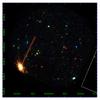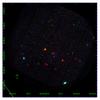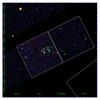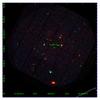Fig. 5

X-ray images as in Fig. 4. Panel a), upper left: XMM-Newton ObsId 0679580201. The brightest source (2XMM J205347.0+442301) (classified as a star by Lin et al. 2012) produces both diffraction spikes and a stripe of out-of-time events, accumulated during CCD readout. The white line outlines the eastern part of ACIS ObsId 13647 FOV. b), upper right: XMM-Newton ObsId 0679580301, toward the highly obscured region LDN 935. The plus sign labeled “O5” is the O star 2MASS J20555125+4352246 from Comerón & Pasquali (2005). c), lower left: archive ACIS-S ObsId 14545. The two white squares indicate ACIS-S chips 6 (front-illuminated, right) and 7 (back-illuminated, left), which have different sensitivities and are analyzed separately. This ObsId also has data from chips 2, 3, and 8, shown in the same figure; however the sensitivity and spatial resolution of these chips is inferior, and they are not considered further here. Near the center of the image, the green plus sign indicates the new FU Ori candidate HBC 722. To the SW a part of ACIS 13648 FOV can be seen. d), lower right: Archive XMM-Newton ObsId 0302640201, just north of ACIS-S ObsId 14545 (seen in lower-right corner). Near image center the FU Ori star V1057 Cyg is labeled.
Current usage metrics show cumulative count of Article Views (full-text article views including HTML views, PDF and ePub downloads, according to the available data) and Abstracts Views on Vision4Press platform.
Data correspond to usage on the plateform after 2015. The current usage metrics is available 48-96 hours after online publication and is updated daily on week days.
Initial download of the metrics may take a while.






